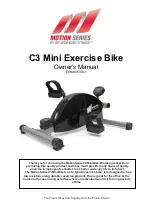
24
Remote Heart Rate Monitor
Monitoring your Heart Rate is one of the best procedures to control the intensity of your exercise. Contact Heart Rate (CHR)
sensors are installed to send your heart rate signals to the Console. The Console can also read telemetry HR signals from a
Heart Rate Chest Strap Transmitter that operates in the 4.5kHz - 5.5kHz range.
Note:
The heart rate chest strap must be an uncoded heart rate strap from
Polar Electro or an uncoded POLAR
®
compatible model. (Coded PO-
LAR
®
heart rate straps such as POLAR
®
OwnCode
®
chest straps will
not work with this equipment.)
If you have a pacemaker or other implanted electronic device, consult your
doctor before using a wireless chest strap or other telemetric heart rate
monitor.
NOTICE:
To prevent interference with the telemetry HR receiver, do not
place any personal electronic devices in the left side of the media tray.
Contact Heart Rate Sensors
Contact Heart Rate (CHR) sensors send your heart rate signals to the Console. The CHR sensors are the stainless steel parts
of the Handlebars. To use, put your hands comfortably around the sensors. Be sure that your hands touch both the top and
the bottom of the sensors. Hold firm, but not too tight or loose. Both hands must make contact with the sensors for the Con-
sole to detect a pulse. After the Console detects four stable pulse signals, your initial pulse rate will be shown.
Once the Console has your initial heart rate, do not move or shift your hands for 10 to 15 seconds. The Console will now
validate the heart rate. Many factors influence the ability of the sensors to detect your heart rate signal:
• Movement of the upper body muscles (including arms) produces an electrical signal (muscle artifact) that can interfere with
pulse detection. Slight hand movement while in contact with the sensors can also produce interference.
•
Calluses and hand lotion may act as an insulating layer to reduce the signal strength.
• Some Electrocardiogram (EKG) signals generated by individuals are not strong enough to be detected by the sensors.
• The proximity of other electronic machines can generate interference.
If your heart rate signal ever seems erratic after validation, wipe off your hands and the sensors and try again.
Heart Rate Calculations
Your maximum heart rate usually decreases from 220 Beats Per Minute (BPM) in childhood to approximately 160 BPM by
age 60. This fall in heart rate is usually linear, decreasing by approximately one BPM for each year. There is no indication that
training influences the decrease in maximum heart rate. Individuals of the same age could have different maximum heart rates.
It is more accurate to find this value by completing a stress test than by using an age related formula.
Your at-rest heart rate is influenced by endurance training. The typical adult has an at rest heart rate of approximately 72
BPM, whereas highly trained runners may have readings of 40 BPM or lower.
The Heart Rate table is an estimate of what Heart Rate Zone (HRZ) is effective to burn fat and improve your cardiovascular
system. Physical conditions vary, therefore your individual HRZ could be several beats higher or lower than what is shown.
OK
PAUSE/
END
QUICK
START
PROGRAMS
GOAL TRACK
Summary of Contents for 270i Recumbent Bike
Page 10: ...10 3 Attach Seat Pads to Seat Frame Assembly 3 6 X8 4mm B E G H X4 2 G I...
Page 11: ...11 4 Attach Cover to Frame Assembly 4 7 5 Attach Seat Adjustment Handle to Frame Assembly...
Page 15: ...15 10 Attach Water Bottle Holder to Frame Assembly 2 X2 F 2...
Page 37: ...37 Maintenance Parts CC BB A AA Z Y D F B C E H I J K L M W X N V P O Q R T S U G...
Page 41: ...41...
Page 42: ...Nautilus Bowflex Schwinn Fitness Universal 8003249 090113 A EN...















































